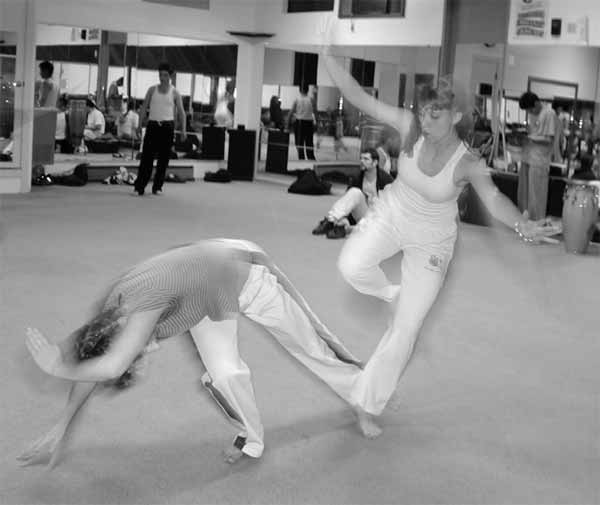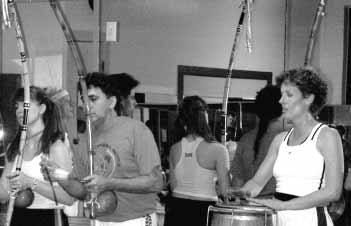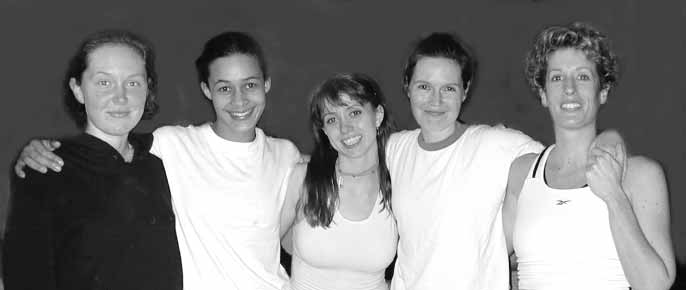

Stacey
Sheldon (Professora) and Bethney Guss (Pippi). Photos by Jerri-Jo
Idarius
|

|
|
Musicians
Bethany, Contramaestre Amunka & Stacey
|
The capoeira game (jojo de capoeira) takes place in a
circular area called a roda pronounced “ho-da.”
An ensemble of singers and musicians at the head of the circle
inspires the players. The primary instrument is the berimbau—a
one-stringed musical bow with a hollowed out gourd (cabaca)
attached. This produces resonating tones when the bowstring
is struck with a thin flexible stick. Other instruments—a
small rattle (caxixi), a notched gourd that is played by scraping
it with a thin stick ganza, a double-headed bell that is played
with a stick or thin metal rod (agogo), a hand drum (atabaque)
and tambourines (pandeiro) — accompany the singing, and
the ritual begins.
Two players enter the circle and squat at the foot of the
berimbau. As the players begin to interact in the circle,
those around them sing, clap and play music. Capoeira becomes
an improvisational conversation in which the players maneuver
one another into vulnerable positions. Generally, strikes
are implied and there is no contact. Only the hands, head
and feet are allowed to touch the floor as the players do
spontaneous cartwheels, handstands, spinning kicks and acrobatics.
The free improvisation of capoeira balances fluid and graceful
dance-like moves with speed and cunning. The absence of hand
techniques is said to be based on an ancient kongo tradition.
Aisha: Every second I am in the capoeira class,
I am conscious that I am a woman. This is primarily because
capoeira was developed by men and therefore for men’s
bodies. For women physically that makes it difficult and more
challenging. The other day I was talking to a guy from Brazil
and I asked him, “How is capoeira different in the United
States?” He said that in Brazil it is acceptable for
women to do dancing or music, but capoeira is a man’s
sport, and the few women who participate are the “crazy
girls,” the ones who don’t care what people think
of them. Here in the United States, more women are doing this
and are encouraged by their teachers. The primary problem
women have is the physical demand on their bodies. Many women
have the advantage of being naturally graceful, flexible and
fluid. Back flexibility is especially helpful in capoeira,
and as a generalization, I would say that men have to work
harder on that. For women, the primary thing we work on is
strength, especially in the upper body.
Capoeira encompasses many energies. If you had this interview
with a man it would be completely different—perhaps more
about fighting. Women have a natural tendency to embrace the
dance side, the gymnastics and the fluidity. Girls do a lot
of back bends, and guys normally jump onto their hands from
a mile away and do back flips. Capoeira can be used any way
you want to use it. I came straight out of a ballet class,
and I was not about to turn into a warrior all of a sudden.
Beth: A few years ago, in 1994, I saw my ex-boyfriend
doing tae kuon do and thought it looked cool; but when I tried
it, I found it wasn’t for me. Aisha was doing capoeira
and told me it was more like dance. I had taken ballet when
I was little, and thought I would check it out. It was so
beautiful. My sister and I began that class. Besides Aisha,
we were the only women there at that time.

THE GAME
Stacey: For me the objective of Capoeira is
to go into the roda, the game, and to become part of the creative
process. Sound and vibration are part of that. The music and
the call and response chant that accompany the games are relatively
trance inducing. The repetitive pulse to the music makes me
lose my sense of individuality. I join this collective sound,
and then I am thrown into a game where I am interacting with
another body—with another energy. Our movements aren’t
choreographed. They are completely spontaneous. The patterns
we create with our bodies and the movements we go through
are fluid, and so familiar to me that I lose myself into a
process of creativity that I don’t personally control.
If I listen to the music and feel the energy of the other
person, then my body knows how to respond. In that moment,
I feel a buzz and a rush. I am tumbling, and the world is
going upside-down and all around and I am laughing, but I
am also fighting. I have gotten to an out-of-body state with
this, but my teacher, Amunka at times calls me back. My guess
is that he does this because I am still a beginner and I could
get hurt.
Aisha: There are several types of capoeira games.
Fighting games are close, with no fancy moves and more straightforward
kicks. Other games involve flips, and even spinning on the
head and hands. This type of game shows common influences
between break-dancing and capoeira. The Angola style games
are closer to the ground and require three parts of the body
to touch the ground at all times—such as the head and
two hands, or two feet and a hand.
Stacey: The ultimate goal of the capoeirista
is to never have conflict. We don’t train to hit each
other. If you see energy coming, you dodge it and move away.
If you were to come after me, I would probably run, but if
you trapped me, I could kick and hurt you. The slaves used
this as a form of recreation, socialization and physical fitness.
Aisha: For me it is much harder to play with
a beginner who is all over the place and has not developed
the full vocabulary of movements. Capoeira is not choreographed,
but there is a base movement and there are various kicks and
moves to learn. At first you train not to hit each other and
to be fluid in motion, but when a maestre plays with you,
he may challenge you by reversing directions in order to keep
you thinking at all times. The maestre also has to be careful
not to hit you if you aren’t able to respond to his trickery.
At times it is nice to go in and play with a person and not
have any idea what level of belt they have achieved. The element
of trickery in capoeira would not be so effective if you always
showed your belt.
TEACHING AND BELTS
Beth: In November I attended a teacher training group in Berkeley
where people came from all over the United States. There are
academies in Santa Rosa, San Francisco, Berkeley, Santa Cruz,
Willits and all over California. Although this art is still
very male dominated, there are some women maestres in the
United States. In a few more years I will become an official
beginning teacher called a formado. However, I can now teach
children as long as I work under a maestre.
Aisha: I have been doing capoeira on and off
for six years. I went away to college for two years and have
been inconsistent even when I have been here. Because of this
I haven’t focused very much on belts. However, I have
progressed through the years and am learning to speak Portuguese
and to play the berimbau. I also taught capoeira classes to
more than thirty students at Bennington College in Vermont.
We didn’t have the standard instruments, but it is an
artsy school and we were willing to be creative. People brought
harmonicas, drums and all sorts of instruments and we had
jam sessions. It worked pretty well, but it wasn’t traditional.
Right now I am on a leave of absence from school. I may not
be returning, so am trying to figure what college to go to
next. I would like to improve my Spanish and Portuguese, to
travel abroad and be a full time dancer. I also want to study
medicine, teaching and physical therapy. Perhaps I will combine
them to become a dance therapist. I have some decisions to
make while I am on this leave of absence.
Stacey: I have been training an average of twice
a week for four or five years. I’m not interested in
the belt level, but I am a yellow belt. There are many different
systems of ranking according to which academy you go to. Our
academy has a green belt for beginners, a green and yellow
belt, yellow belt, blue and green belt, yellow and blue belt,
blue belt, and so forth. The white belt is equivalent to a
tenth degree black belt in judo. Our teacher is a contramestre.
The next level above that is maestre.
BODY COMMUNICATION
Stacey: A beautiful part of capoeira is the
opportunity for creative collaboration. I work all day as
a teacher where people are always using words as a way to
share energy. What I like about capoeira is that I can go
to classes and not talk much. We can have conversations through
our bodies, or through a look. As a tribe, we are all throwing
in different sounds or movements to create a group process
that involves more than the interaction between the two people
in the center of the circle. They are also responding to sounds
of the musicians. I can be on the tambourine with its “chu-che-choom-poom,
chu-che-choom-poom” rhythm, and I can make Beth kick
right at that “poom” of the tambourine. She may
not even be aware that it is my tambourine that’s giving
her the direction for a sharp kick. I can be on the berimbau
with its “bow-wow-wow, bow-wow-wow” sound and make
her start swaying and become like a snake. People also use
their voices and the clapping of their hands. With these we
are all creating signals that make something happen.
Beth: The people who enter into the play come
in spontaneously. The natural energy between some people makes
interaction easy. I can tell in the first few seconds how
to play with a person—if the energy is going to flow
or if I have to play cautiously or be aggressive with them.
I match their energy.
Stacey: I sometimes like to release the stress
of work in little sparring games. I’m not malicious,
but sometimes I may express a high-energy kick-kick-kick combat
style. If I am in a mellower space, I like to bring the more
acrobatic, graceful and slow moving qualities to the play.
SOCIETAL PROGRAMMING
Aisha: Doing capoeira, I have always been well
supported as a woman; but I saw one woman get beat up on the
streets of the city. She is really good, and a guy from Brazil
who considered himself one of the best started ego-tripping
on that and felt he needed to prove himself. He was horrible
to her, and grabbed her in places he shouldn’t have,
pushing her, kicking her really hard. He was out of control
and really brutal.
If I tried to be a real fighter I might also run into situations
where guys would be too violent with me. Luckily I am pretty
mellow and am not trying to get people riled up to fight with
me, but I have to be careful. However, I have to say that
some women who have tried to equal themselves to men in strength
have done very well. I know of one woman in New York who is
very tough. I would like to challenge myself and gain that
type of strength sometime in my life.
Stacey: The play of capoeira breaks down all
cultural barriers, age barriers, language barriers and gender
barriers. We have had students from Vietnam, Mexico, and other
countries, and even when we don’t speak the same language,
we can have a good time together. We have students from age
nine to their fifties. You don’t have to be strong to
be a capoeirista. You can create your own style.
Beth: Our society has programmed teenagers to
be so self-conscious that it is hard for them to break out
of gender stereotypes. They don’t want to be kicking
or flying through the air or looking a little crazy. Normally
it is best to start training kids before puberty—when
they aren’t scared of their bodies or of what others
might think. Then it is easier for them to keep going through
their teen years.
Stacey: When I first started playing capoeira
I tried to target the young women. I am aware of their sensitivity
to the standards and ideals that society sets for them, and
their tendency to lose their individuality by trying to program
themselves into a cookie-cutter ideal. I teach eleventh and
twelfth grade British and American literature classes at the
high school, and see women in my classes who don’t have
a strong sense of their physical power or intellectual prowess.
They often try to make themselves invisible. I say, “Hey,
come and play capoeira!” The training is beneficial in
a lot of arenas in life. However, none of the young women
I have talked with have been interested.
I have also tried to get friends, both male and female, to
come and join. But I realize that if it is not in a person’s
soul to learn this—if they don’t love and desire
it on their own—then it won’t happen.
For me that love was immediate. It was similar to the first
time I ever smelled sage. I was about twenty years old and
was on a college campus. When I smelled the sage, I started
crying because there was something so familiar about it to
me. I had that same feeling and started crying when I first
saw capoeira. It was like something I had been missing that
I suddenly rediscovered.
THE BIGGER PICTURE
Beth: I feel like I am in a family, a tribe. The energy I
receive from everyone in capoeira creates a constant hum that
I feel and love. If I could be at class every day I would—just
to get back to that feeling. I live for that. I haven’t
been able to find this experience anywhere else. In ballet
and modern dance, I went through the motions of dance, but
I didn’t get that feeling of connection. The energy hum
is always just right there, and creates an intensity and desire
to play that gets my heart racing.
Stacey: Capoeira has much to offer anyone who
is willing to play—and particularly women. Women in this
culture aren’t encouraged to be physically assertive.
Capoeira helps us get into our bodies and to take up more
space than we are usually allowed. At the high school, I look
at how the men and women in my classes are in their bodies.
The guys sit at their desks relaxed, with their legs apart.
The women make their bodies as small as possible. Their shoulders
come down to hide their chest, and they keep their legs closed
like good girls. As women, we tend to hold ourselves in tiny
little balls.
Capoeira reminds me to take up some space and
even a little more—to be physically assertive. It also
encourages me to take risks. Since playing capoeira, I am
much more willing to do that and if I mess up, it’s no
big deal. Girls are always saying, “I’m sorry, I’m
sorry, I’m sorry,” or “Am I getting this right?”
Guys don’t care if they screw up. They just try again.
With capoeira, if you have a bad game, you go back in and
play again. If you mess up, it’s okay. You get another
chance. For me, this translates to other areas in my life
as well.
This art form also lends itself to spiritual reflection. When
I play with another person, I become a mirror to them, and
they become a mirror for me. I see myself more clearly because
I see what kind of energy I am putting out and who I am when
I play. I wouldn’t see that being just by myself.
For more information about capoeira classes
and events in Ukiah, call Amunka at (707) 462-1342. A comprehensive
website has been established by his teacher Bira Almeda (aka
Acordeon) at website: www.capoeiraarts.com